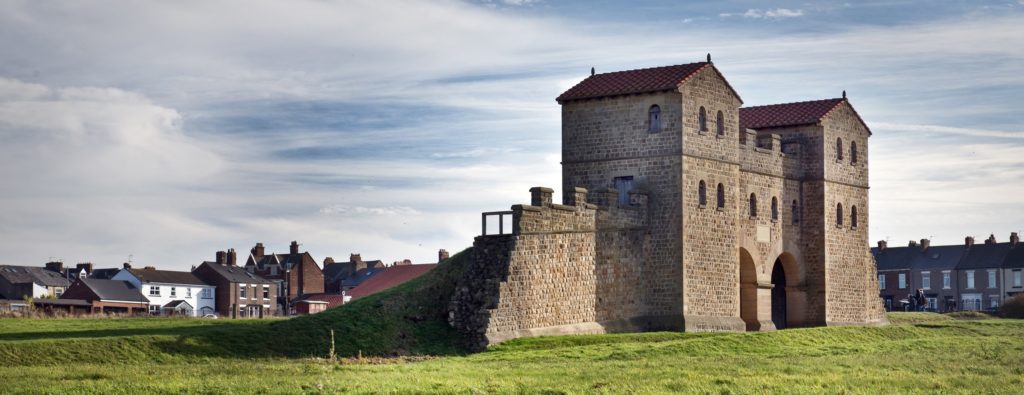Despite its proximity to North Shields and Tynemouth, the story of South Shields weaves its own way through the ages. In Roman times, it was quite clearly a large, rich and cosmopolitan town and according to the archaeological record, the burgh’s significance was sustained for several centuries after the Romans abandoned Britain.

What Was Caer Urfa?
There is a long record of prehistoric settlement on the Lawe, which in ancient times formed its own island. In contrast to Penbalcrag, however, the stronghold called Caer Urfa appears to derive its name from the post-Roman settlement.
We again have the 16th century antiquary John Leland to thank for passing down this name to us. He mentions Caer Urfa in the very same passage he describes Tinemuth and Benebalcrag, stating:
E regione Tinemuthæ suit urbs vastata à Danis Urfa nomine
[margin note: Caire Urfe],
ubi natus erat Oswinus rex.
On the other side of Tynemouth lies a city destroyed by the Danes called Urfa
[margin note:] Caire Urfe,
where King Oswin was born.
Antiquarii Collectanea, Volume IV, Tome III, p45

The name and its eminence is reiterated by Leland in another section where he augments the list of 28 ancient British cities in the Historia Anglorum by Henry of Huntingdon (d.1155).
Monachi Tinenses dicunt civitatem fuisse in ulteriore ripa ostii Tinae flu Caerurfe nomine, ubi natus erat rex Oswi.
The monks of Tynemouth say that there was a city on the further bank of the River Tyne called Caerurfe, where King Oswi[n] was born.
Antiquarii Collectanea, Volume III, Tome II, p290
Then there’s a third reference in Leland’s Itinerary, Vol 6 where he annotates a quotation from an earlier anonymous work, which is lost.
“Ferunt quidam S. regem Oswinum natum in quodam castro Burgh antiquitus nuncupato, cujus fundumenta pro parte adhuc manet ex australi parte aquae de Tina prope Southesheles in territoria quod nunc est Prioris Dunelmi,”
[margin note:] Burgh Castellum ad australem partem Tini. Vide num sit Cairuruach.
“There are some who say that the holy king Oswin was born in an ancient camp called Burgh, the foundations of which still partly remain on the south side of the Tyne water, near South Sheles, in the territory which now belongs to the Prior of Durham,”
[margin note:] Burgh Castle on the south side of the Tine. See whether it is Cairuruach.
Quoted text: ‘Ex historia incerti auctoris de paucis Northumbr. regibus & episcopis Transhumbranis’
Itinerary, Vol 6, Folio 34, p32
Cair Uruach is an old name for Wroxeter in Shropshire and is included in the traditional 28 ancient Caers of Britain that had been circulating in historical texts, not just from Henry of Huntingdon in the 12th century, but since Gildas and Nennius in 6th and 9th centuries respectively. Caer Urfe on the other hand, was not included in this standard list and was added by Leland to his own iteration of the list (ref above).
Leland had discovered for himself the name ‘Caer Urfa’ for the settlement on South Shields Lawe, just as he had discovered the name ‘Benebalcrag’ for the Tynemouth headland. He learned these names from the monks at Tynemouth Priory around the time of the dissolution of the monasteries by Henry VIII, to whom he was antiquary. He also learned a great deal of other local knowledge from the monks, such as the nature of the Danish invasions as well as South Shields being a seat of royalty and the birthplace of Oswin, the foundation saint of Tynemouth Priory.
Leland then, naturally added Caer Urfe to the list of British Caers, as he knew that it had been a large and important burgh. The location of Caer Uruach, meanwhile, was a mystery to scholars until the antiquary William Camden, very much a successor to Leland, pinpointed it as Wroxeter in the early 17th century.
Armed with this virtually secret historical local knowledge, Leland had a clue for the location of similar sounding but hitherto unknown Caer Uruach. The inclusion of ‘Cairuruach’ in his notes, beside a quotation regarding King Oswin and South Shields, is a reminder for him to look for possible a link between Uruach and Urfe.
The reality though is that Caer Uruach was not in the North East and the list of Caers was quite a Welsh and southern-centric document, compiled by Welsh scribes long ago in the mists of antiquity. Nevertheless, despite Caer Uruach and Caer Urfe not being one and the same, what these three citations above show us, is that they all irrefutably point to South Shields as a major early medieval centre in the region.
Notes
Leland’s vast body of writing was mostly notes and poetry and was left largely unpublished. His archives were organised and edited in the 18th century, long after his life.
Curiously there is actually a Celtic connection between Caers Uruach and Urfe in that the famous hill called the Wrekin in Shropshire is close by Wroxeter, and the Saxon name for Wroxeter was Wrekencester. Similarly the ancient Roman road leading from South Shields to Cade’s Road, which ran from York to Newcastle, is called the Wrekendyke. They possibly have the same linguistic origin in reference to the giant of Welsh folklore, Wrnach.
Plenty has been discussed about the etymology of Caer Urfa and Arbeia, with many interesting theories. I might speculate on that in another post. But my basic view is that the evidence for the connection with Mesopotamia during the late-Roman age is strong, and that the answers lie along that line of enquiry.
Reference
Archaeologia Aeliana, Volume XIX (1898), Abbess Hilda’s First Religious House by Rev. H.E. Savage, p69-70
The collected notes of the antiquary John Leland




